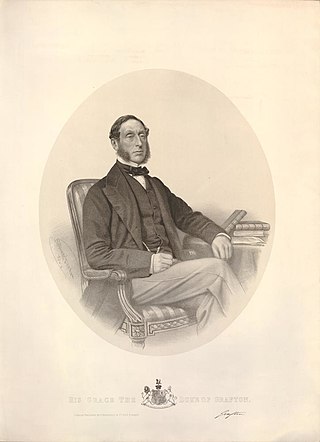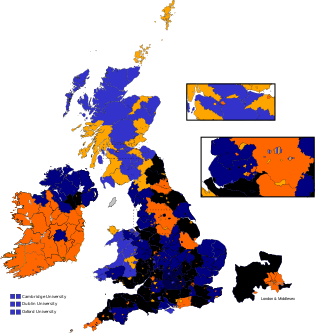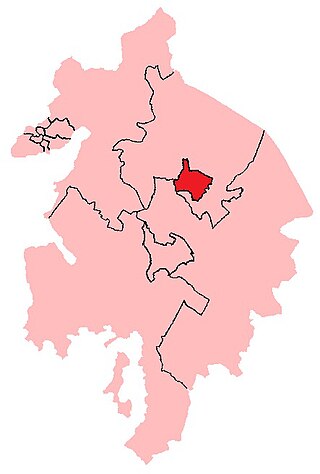| Thetford | |
|---|---|
| Former Borough constituency for the House of Commons | |
| County | Norfolk |
| 1529–1868 | |
| Seats | Two |
| Replaced by | West Norfolk |
Thetford was a constituency of the British House of Commons. It elected two Members of Parliament (MPs) by the bloc vote system of election. It was disenfranchised under the Representation of the People (Scotland) Act 1868, which had resulted in a net increase of seven seats in Scotland, offset by the disenfranchisement of seven English Boroughs.
Below are those MPs who held the seat from just prior to the Restoration onwards.
Due to the town's close proximity to Euston Hall (the main residence of the FitzRoy family), the seat for Thetford has been held by various members of the family:
| Party | Candidate | Votes | % | ||
|---|---|---|---|---|---|
| Whig | Lord James FitzRoy | Unopposed | |||
| Whig | Francis Baring | Unopposed | |||
| Registered electors | 31 | ||||
| Whig hold | |||||
| Whig hold | |||||
| Party | Candidate | Votes | % | ||
|---|---|---|---|---|---|
| Whig | Lord James FitzRoy | Unopposed | |||
| Tory | Alexander Baring | Unopposed | |||
| Registered electors | 31 | ||||
| Whig hold | |||||
| Tory gain from Whig | |||||
| Party | Candidate | Votes | % | ||
|---|---|---|---|---|---|
| Whig | Lord James FitzRoy | Unopposed | |||
| Tory | Francis Baring | Unopposed | |||
| Registered electors | 146 | ||||
| Whig hold | |||||
| Tory hold | |||||
FitzRoy's death caused a by-election.
| Party | Candidate | Votes | % | ||
|---|---|---|---|---|---|
| Whig | Henry FitzRoy | Unopposed | |||
| Whig hold | |||||
| Party | Candidate | Votes | % | ||
|---|---|---|---|---|---|
| Whig | Henry FitzRoy | Unopposed | |||
| Conservative | Francis Baring | Unopposed | |||
| Registered electors | 160 | ||||
| Whig hold | |||||
| Conservative hold | |||||
| Party | Candidate | Votes | % | ||
|---|---|---|---|---|---|
| Whig | Henry FitzRoy | Unopposed | |||
| Conservative | Francis Baring | Unopposed | |||
| Registered electors | 161 | ||||
| Whig hold | |||||
| Conservative hold | |||||
| Party | Candidate | Votes | % | ±% | |
|---|---|---|---|---|---|
| Conservative | Bingham Baring | 86 | 37.7 | N/A | |
| Whig | Henry FitzRoy | 71 | 31.1 | N/A | |
| Conservative | James Flower | 71 | 31.1 | N/A | |
| Turnout | 137 | 87.8 | N/A | ||
| Registered electors | 156 | ||||
| Majority | 15 | 6.6 | N/A | ||
| Conservative hold | Swing | N/A | |||
| Majority | 0 | 0.0 | N/A | ||
| Whig hold | Swing | N/A | |||
| Conservative win | |||||
Due to the triple return, on petition, one vote was knocked off FitzRoy's total and Flower was declared elected in 1842.
Baring was appointed Paymaster General, requiring a by-election.
| Party | Candidate | Votes | % | ±% | |
|---|---|---|---|---|---|
| Conservative | Bingham Baring | Unopposed | |||
| Conservative hold | |||||
| Party | Candidate | Votes | % | ±% | |
|---|---|---|---|---|---|
| Conservative | Bingham Baring | Unopposed | |||
| Whig | William FitzRoy | Unopposed | |||
| Registered electors | 200 | ||||
| Conservative hold | |||||
| Whig hold | |||||
Baring succeeded to the peerage, becoming 2nd Baron Ashburton and causing a by-election.
| Party | Candidate | Votes | % | ±% | |
|---|---|---|---|---|---|
| Conservative | Francis Baring | Unopposed | |||
| Conservative hold | |||||
| Party | Candidate | Votes | % | ±% | |
|---|---|---|---|---|---|
| Conservative | Francis Baring | Unopposed | |||
| Whig | William FitzRoy | Unopposed | |||
| Registered electors | 200 | ||||
| Conservative hold | |||||
| Whig hold | |||||
| Party | Candidate | Votes | % | ±% | |
|---|---|---|---|---|---|
| Conservative | Francis Baring | Unopposed | |||
| Whig | William FitzRoy | Unopposed | |||
| Registered electors | 218 | ||||
| Conservative hold | |||||
| Whig hold | |||||
Baring resigned, causing a by-election.
| Party | Candidate | Votes | % | ±% | |
|---|---|---|---|---|---|
| Conservative | Alexander Baring | Unopposed | |||
| Conservative hold | |||||
| Party | Candidate | Votes | % | ±% | |
|---|---|---|---|---|---|
| Conservative | Alexander Baring | Unopposed | |||
| Liberal | William FitzRoy | Unopposed | |||
| Registered electors | 231 | ||||
| Conservative hold | |||||
| Liberal hold | |||||
FitzRoy succeeded to the peerage, becoming 6th Duke of Grafton and causing a by-election.
| Party | Candidate | Votes | % | ±% | |
|---|---|---|---|---|---|
| Liberal | Lord Frederick FitzRoy | 93 | 53.4 | N/A | |
| Conservative | Robert Harvey | 81 | 46.6 | N/A | |
| Majority | 12 | 6.8 | N/A | ||
| Turnout | 174 | 75.0 | N/A | ||
| Registered electors | 232 | ||||
| Liberal hold | Swing | N/A | |||
| Party | Candidate | Votes | % | ±% | |
|---|---|---|---|---|---|
| Conservative | Robert Harvey | 193 | 48.4 | N/A | |
| Liberal | Alexander Baring | 137 | 34.3 | N/A | |
| Liberal | Thomas Dakin [11] | 69 | 17.3 | N/A | |
| Majority | 124 | 31.1 | N/A | ||
| Turnout | 200 (est) | 89.1 (est) | N/A | ||
| Registered electors | 224 | ||||
| Conservative gain from Liberal | Swing | N/A | |||
| Liberal hold | Swing | N/A | |||
Baring resigned, causing a by-election.
| Party | Candidate | Votes | % | ±% | |
|---|---|---|---|---|---|
| Conservative | Edward Gordon | Unopposed | |||
| Conservative gain from Liberal | |||||

Duke of Grafton is a title in the Peerage of England. It was created in 1675 by Charles II of England for Henry FitzRoy, his second illegitimate son by the Duchess of Cleveland. The most notable duke of Grafton was Augustus FitzRoy, 3rd Duke of Grafton, who served as Prime Minister from 1768–1770.

Berwick-upon-Tweed is a parliamentary constituency in Northumberland represented in the House of Commons of the UK Parliament since 2015 by Anne-Marie Trevelyan, a Conservative.
Forfarshire was a Scottish county constituency represented in the House of Commons of Great Britain from 1708 until 1800, and then in the House of Commons of the United Kingdom until 1950.

George Henry FitzRoy, 4th Duke of Grafton, KG, styled Earl of Euston until 1811, was a British peer and Whig politician who sat in the House of Commons from 1782 to 1811 when he succeeded to the Dukedom.

William Henry Fitzroy, 6th Duke of Grafton, styled Viscount Ipswich until 1847 and Earl of Euston between 1847 and 1863, was a British peer and Liberal Party politician. He was born in London and educated at Harrow, and after went to the Royal Military College, Sandhurst.
County Antrim is a former county constituency in the House of Commons of the United Kingdom. It was a two-member constituency in Ireland from 1801 to 1885 and in Northern Ireland from 1922 to 1950.
Bishop's Castle was a borough constituency in Shropshire represented in the House of Commons of the Parliament of the United Kingdom.
Much Wenlock, often called simply Wenlock, was a constituency of the House of Commons of the Parliament of England until 1707, then of the Parliament of Great Britain from 1707 to 1800, and finally of the Parliament of the United Kingdom from 1801 to 1885, when it was abolished. It was named after the town of that name in Shropshire.
Carmarthenshire was a parliamentary constituency in Wales which returned one Member of Parliament (MP) to the House of Commons of the Parliament of the United Kingdom until its representation was increased to two members for the 1832 general election.
Appleby was a parliamentary constituency in the county of Westmorland in England. It existed for two separate periods: from 1295 to 1832, and from 1885 to 1918.

East Kent was a county constituency in Kent in South East England. It returned two Members of Parliament (MPs) to the House of Commons of the Parliament of the United Kingdom, elected by the first past the post system.

Coventry was a borough constituency which was represented in the House of Commons of England and its successors, the House of Commons of Great Britain and the House of Commons of the United Kingdom.
Newcastle-upon-Tyne was a parliamentary borough in the county of Northumberland of the House of Commons of England from 1283 to 1706, then of the House of Commons of Great Britain from 1707 to 1800 and of the House of Commons of the United Kingdom from 1801 to 1918. It returned two Members of Parliament (MPs), elected by the bloc vote system.
Bletchingley was a parliamentary borough in Surrey. It returned two Members of Parliament (MPs) to the House of Commons of England from 1295 to 1707, to the House of Commons of Great Britain from 1707 to 1800, and to the House of Commons of the United Kingdom until 1832, when the constituency was abolished by the Great Reform Act.
Francis Baring, 3rd Baron Ashburton was an American-born British politician and peer.

Lieutenant-Colonel Lord Charles FitzRoy, was a British soldier and Whig politician. He fought at the Battle of Waterloo at an early age and later held political office as Vice-Chamberlain of the Household between 1835 and 1838.

John Charles Ramsden was a British Whig politician from Newby Park in Yorkshire. He had a seat in the House of Commons between 1812 and 1836.
William Russell of Brancepeth Castle in County Durham was a British Whig politician. He sat in the House of Commons between 1822 and 1832.

Henry Oliver Charles FitzRoy, 12th Duke of Grafton, known as Harry Grafton, is an English peer and music promoter. He inherited the Dukedom of Grafton from his grandfather, Hugh FitzRoy, 11th Duke of Grafton, on 7 April 2011. He is also a direct male-line descendant of Charles II of England.
Lord John Edward FitzRoy, was a British politician.